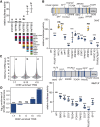A flexible repertoire of transcription factor binding sites and a diversity threshold determines enhancer activity in embryonic stem cells
- PMID: 33712417
- PMCID: PMC8015845
- DOI: 10.1101/gr.272468.120
A flexible repertoire of transcription factor binding sites and a diversity threshold determines enhancer activity in embryonic stem cells
Abstract
Transcriptional enhancers are critical for development and phenotype evolution and are often mutated in disease contexts; however, even in well-studied cell types, the sequence code conferring enhancer activity remains unknown. To examine the enhancer regulatory code for pluripotent stem cells, we identified genomic regions with conserved binding of multiple transcription factors in mouse and human embryonic stem cells (ESCs). Examination of these regions revealed that they contain on average 12.6 conserved transcription factor binding site (TFBS) sequences. Enriched TFBSs are a diverse repertoire of 70 different sequences representing the binding sequences of both known and novel ESC regulators. Using a diverse set of TFBSs from this repertoire was sufficient to construct short synthetic enhancers with activity comparable to native enhancers. Site-directed mutagenesis of conserved TFBSs in endogenous enhancers or TFBS deletion from synthetic sequences revealed a requirement for 10 or more different TFBSs. Furthermore, specific TFBSs, including the POU5F1:SOX2 comotif, are dispensable, despite cobinding the POU5F1 (also known as OCT4), SOX2, and NANOG master regulators of pluripotency. These findings reveal that a TFBS sequence diversity threshold overrides the need for optimized regulatory grammar and individual TFBSs that recruit specific master regulators.
© 2021 Singh et al.; Published by Cold Spring Harbor Laboratory Press.
Figures





Similar articles
-
Transposable Elements and DNA Methylation Create in Embryonic Stem Cells Human-Specific Regulatory Sequences Associated with Distal Enhancers and Noncoding RNAs.Genome Biol Evol. 2015 May 7;7(6):1432-54. doi: 10.1093/gbe/evv081. Genome Biol Evol. 2015. PMID: 25956794 Free PMC article.
-
Synthetic and genomic regulatory elements reveal aspects of cis-regulatory grammar in mouse embryonic stem cells.Elife. 2020 Feb 11;9:e41279. doi: 10.7554/eLife.41279. Elife. 2020. PMID: 32043966 Free PMC article.
-
Reciprocal transcriptional regulation of Pou5f1 and Sox2 via the Oct4/Sox2 complex in embryonic stem cells.Mol Cell Biol. 2005 Jul;25(14):6031-46. doi: 10.1128/MCB.25.14.6031-6046.2005. Mol Cell Biol. 2005. PMID: 15988017 Free PMC article.
-
Transcription factors for the modulation of pluripotency and reprogramming.Cold Spring Harb Symp Quant Biol. 2010;75:237-44. doi: 10.1101/sqb.2010.75.003. Epub 2010 Nov 3. Cold Spring Harb Symp Quant Biol. 2010. PMID: 21047904 Review.
-
Roles of ZIC2 in Regulation of Pluripotent Stem Cells.Adv Exp Med Biol. 2018;1046:339-351. doi: 10.1007/978-981-10-7311-3_17. Adv Exp Med Biol. 2018. PMID: 29442330 Review.
Cited by
-
Characterization of enhancer activity in early human neurodevelopment using Massively Parallel Reporter Assay (MPRA) and forebrain organoids.Sci Rep. 2024 Feb 16;14(1):3936. doi: 10.1038/s41598-024-54302-7. Sci Rep. 2024. PMID: 38365907 Free PMC article.
-
Deciphering the multi-scale, quantitative cis-regulatory code.Mol Cell. 2023 Feb 2;83(3):373-392. doi: 10.1016/j.molcel.2022.12.032. Epub 2023 Jan 23. Mol Cell. 2023. PMID: 36693380 Free PMC article. Review.
-
Characterization of enhancer activity in early human neurodevelopment using Massively parallel reporter assay (MPRA) and forebrain organoids.bioRxiv [Preprint]. 2023 Aug 14:2023.08.14.553170. doi: 10.1101/2023.08.14.553170. bioRxiv. 2023. Update in: Sci Rep. 2024 Feb 16;14(1):3936. doi: 10.1038/s41598-024-54302-7. PMID: 37645832 Free PMC article. Updated. Preprint.
-
Transcriptional kinetic synergy: A complex landscape revealed by integrating modeling and synthetic biology.Cell Syst. 2023 Apr 19;14(4):324-339.e7. doi: 10.1016/j.cels.2023.02.003. Cell Syst. 2023. PMID: 37080164 Free PMC article.
-
Super-enhancers conserved within placental mammals maintain stem cell pluripotency.Proc Natl Acad Sci U S A. 2022 Oct 4;119(40):e2204716119. doi: 10.1073/pnas.2204716119. Epub 2022 Sep 26. Proc Natl Acad Sci U S A. 2022. PMID: 36161929 Free PMC article.
References
-
- Ballester B, Medina-Rivera A, Schmidt D, Gonzàlez-Porta M, Carlucci M, Chen X, Chessman K, Faure AJ, Funnell APPW, Goncalves A, et al. 2014. Multi-species, multi-transcription factor binding highlights conserved control of tissue-specific biological pathways. eLife 3: e02626. 10.7554/eLife.02626 - DOI - PMC - PubMed
Publication types
MeSH terms
Substances
Grants and funding
LinkOut - more resources
Full Text Sources
Other Literature Sources
Research Materials
